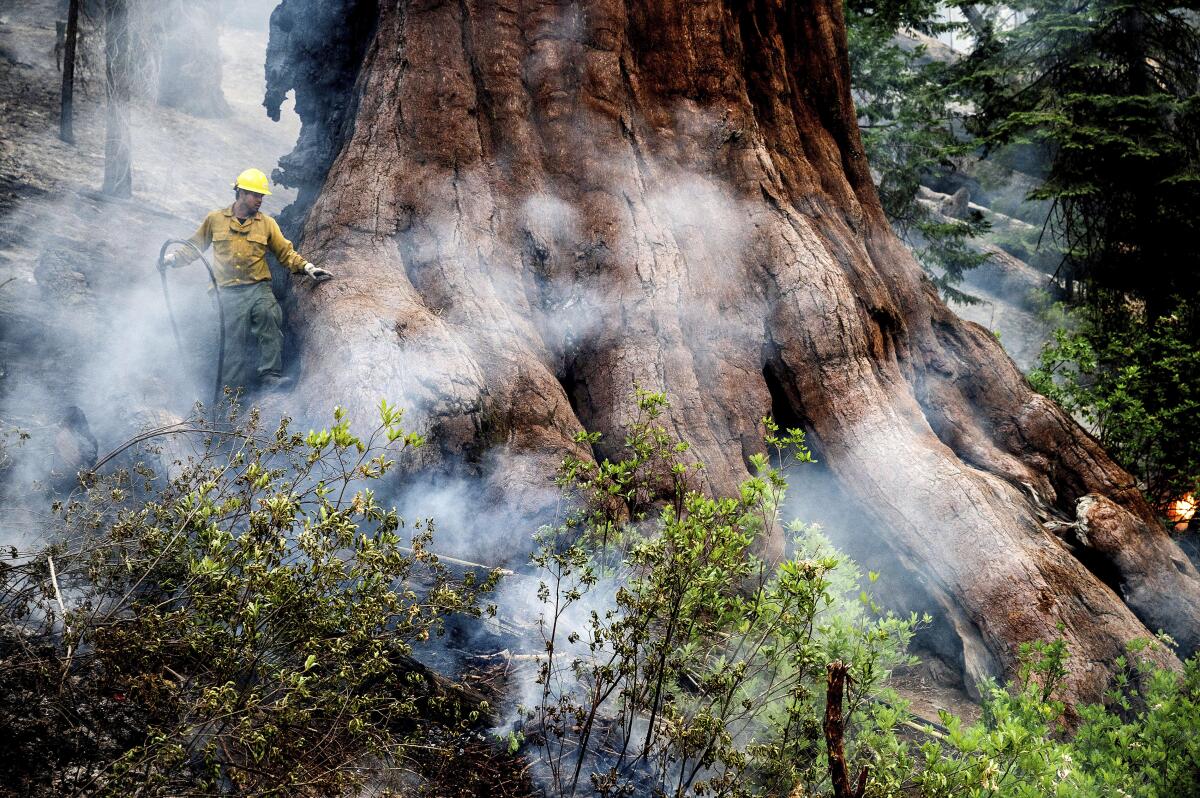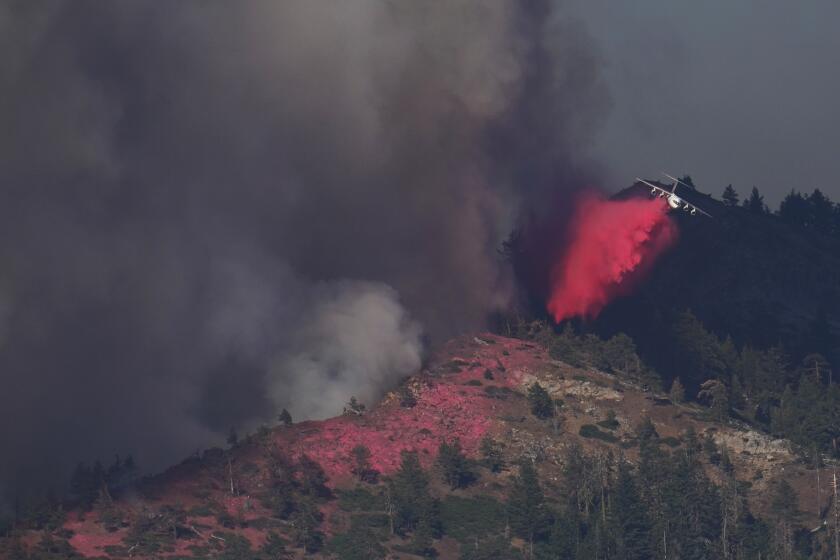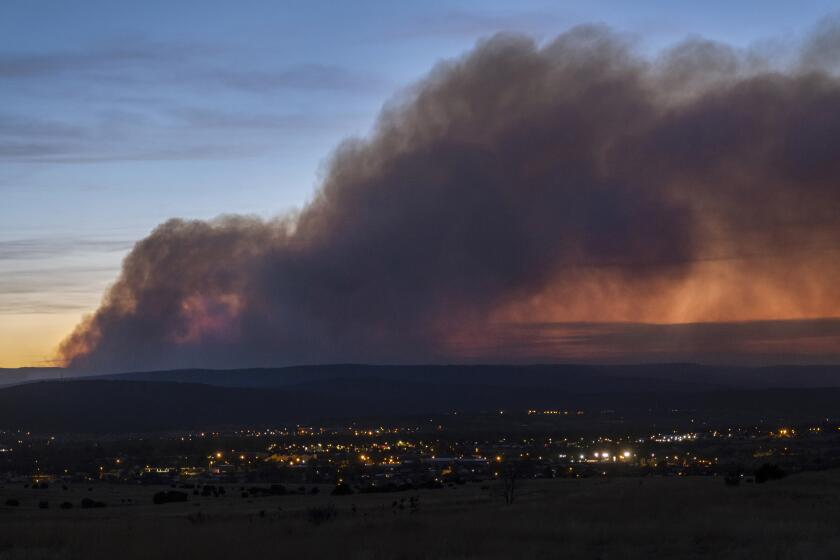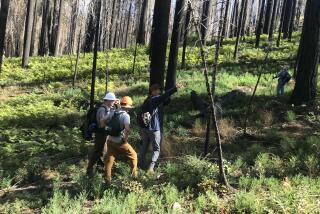Op-Ed: Face it, Yosemite lovers — sprinklers can’t save the Mariposa Grove forever

Californians are shutting off their irrigation systems to reduce water consumption amid a devastating, climate-driven drought. In Yosemite National Park, sprinklers were turned on in hopes of slowing the climate-driven Washburn fire from threatening the Mariposa Grove of giant sequoias.
The differences are instructive. Embracing brown lawns is a proactive commitment to a more climate-resilient landscape. The Mariposa sprinklers, deployed to protect such iconic trees as the Grizzly Giant, are a denial of the climate realities that have made the Sierra increasingly vulnerable to wildfire.
The same kind of denial is evident in two problematic ideas that frame the concerted effort to stop the Washburn blaze — preservationism and fire suppression.
Start with the preservation ethos, the concept that some places are so special that they should be set aside and sustained unchanged across time. Naturalist John Muir made this case for Yosemite and the Mariposa Grove. The latter, he wrote to a friend in 1869, was unique because it sheltered so many giant sequoias and did so “in all the majesty and grandeur of nature undisturbed.”
The fire, which more than doubled in size over the weekend, was burning at the edge of Yosemite’s Mariposa Grove, home to the Grizzly Giant and other sequoias.
Muir would spend a lifetime defending what he believed was an untrammeled and divine sanctuary. In 1902, while guiding President Theodore Roosevelt through Yosemite to convince the conservationist-in-chief that the then-state park required federal protection, their first stop was the Mariposa Grove, “the solemn temple of the giant sequoias.” Four years later, during Roosevelt’s second term, the national park became a reality.
Preservationism was embedded in the National Park Service’s establishing act of 1916. The new agency’s mission was “to conserve the scenery and the natural and historic objects and the wild life therein and to provide for the enjoyment of the same in such manner and by such means as will leave them unimpaired for the enjoyment of future generations.”
The daunting requirement to maintain these landscapes unimpaired forever is one reason why firefighters looped sprinklers around the nearly 3,000-year-old Grizzly Giant. It was “preventative first aid,” forest ecologist Garrett Dickman said in video posted on a Yosemite website two days after the Washburn fire was reported. “We really don’t want to leave this one to chance, because this really is such an iconic tree.”
Fire managers’ decision to throw all available resources, human and mechanical, at the Washburn fire, was also expedient. No park superintendent wants to be in the position of losing sequoias, a fear made manifest in 2021 when the Windy and KNP Complex fires tore through Sequoia National Forest, as well as Kings Canyon and Sequoia National Parks, incinerating large numbers of the trees.
A history of smart fire-management, as opposed to fire suppression, may have helped protect the Mariposa Grove. A U.S. Forest Service spokesman told The Times that prescribed burning and fuel thinning played a role in keeping the Washburn fire at bay in the park.
The fire grew to 4,261 acres and was 23% contained, authorities said.
But prescribed burning can be an uncertain, controversial tool. Consider the bruising criticism the Forest Service came in for in May when a prescribed fire blew up into the Hermit’s Peak-Calf Canyon fire, which torched forest, towns and ranches across more than 340,000 acres in the largest conflagration in New Mexico’s history.
That was not what fire managers wanted, of course. Quite the reverse: Prescribed fires introduce controlled, far less destructive (some say restorative) burns into forested ecosystems designed to burn periodically. They have a mostly positive record — 99.84% of the time they go as planned, according to the Forest Service. When one doesn’t, however, the backlash is severe.
New Mexico state and federal politicians want the federal government to pick up all costs of the Hermit’s Peak-Calf Canyon fire — including compensation for fire victims — and they called for an immediate halt to the use of controlled burns everywhere. The Forest Service’s chief, Randy Moore, complied, announcing a 90-day moratorium nationwide to conduct a “learning review,” effectively handcuffing preemptive action during the hot summer months.
By contrast, there are no apparent public relations or political consequences for full-on suppression. Indeed, the praise the Park Service and other agencies have received for their energetic attack on the Washburn fire is a clear incentive to act with dispatch whenever and wherever wildfires erupt.
Miscalculations, inaccurate models and underestimation of dry conditions turned a controlled burn into New Mexico’s largest wildfire ever recorded.
That said, conflict avoidance is rarely good public policy, especially at a time when government agencies must make judicious, long-term decisions about how to respond to the powerful impact that climate change is having on the landscapes they manage. Parkland and national monuments cannot be “set aside” from reality.
For the Park Service, this reckoning is particularly critical. After all, climate change not only has altered historic weather patterns, extended fire seasons through the year and rearranged longstanding ecological relationships, it is inexorably disrupting the agency’s founding preservationist principles.
As much as the Washburn fire tactics caused a sigh of relief among Yosemite lovers, the Park Service needs to acknowledge that it makes no sense to install sprinklers to protect giant sequoias from conversions that a warming planet is unleashing in the Mariposa Grove and elsewhere.
Its concession must also be ours. We cannot irrigate our way out of climate change. Not for our grass or for our groves.
Char Miller is a professor of environmental history at Pomona College. His new book, “Natural Consequences: Intimate Essays for a Planet in Peril,” will be published in September.
More to Read
A cure for the common opinion
Get thought-provoking perspectives with our weekly newsletter.
You may occasionally receive promotional content from the Los Angeles Times.













